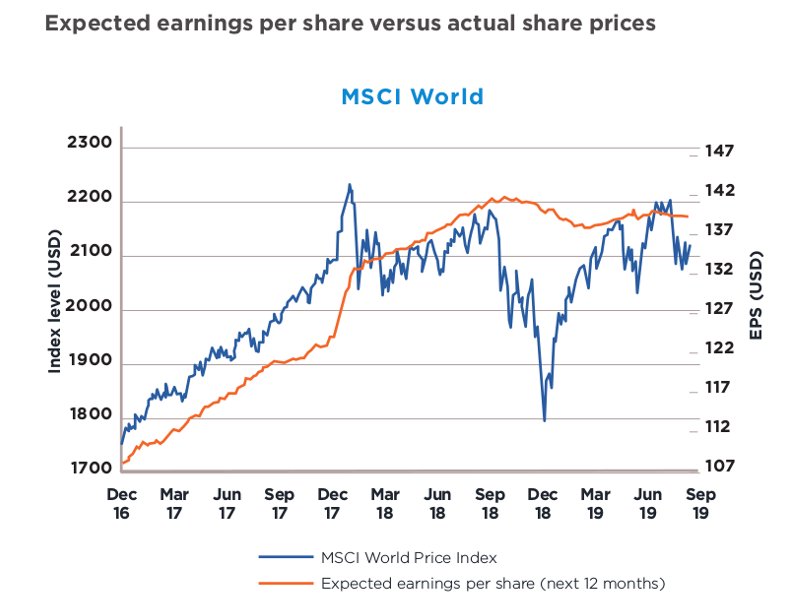Risks are inevitable and not to be feared
Risks are inevitable and not to feared
Towards the end of last month, we took another step closer to a ‘no deal’ Brexit with the approval of a suspended parliament in September. While critics declared it a ‘constitutional outrage’, it was the latest twist in what has been an extraordinary political saga. As several risk factors converge (Brexit, US-China trade war, the threat of recession and inflation concerns), the outlook for the remainder of 2019 is unquestionably opaque. But to what extent should investors worry? Here we discuss the risks at large, and why they are not necessarily to be feared.
Brexit: why deal/ no deal is not really the question
Even if we were to experience the hardest of Brexits, we’re confident portfolios would feel little impact. Our exposure to UK stocks is limited, and where we do have exposure those companies tend to earn revenues globally. Given that a hard Brexit is likely to be accompanied by a falling pound; such UK-based companies will get a boost in value in sterling terms. Ironically, the biggest risk to investors is if the pound rallies in the wake of a deal, and gilts are sold off. But there will also be positives associated with that outcome – not least the fact that we will have some certainty at long last. In the main, we’re comfortable that clients are not over-exposed to the Brexit risk – whatever the outcome.
A trade war at large
The trade war between the US and China means that businesses around the world must deal with ongoing cost and supply chain uncertainty. While this sounds worrying, we must put this into perspective. When Japan was devastated by the tsunami in 2011, businesses around the world had their supply chain cut off overnight. Indeed, some companies were 100% reliant on Japan for critical component parts. While lessons were learned in terms of over-dependence and diversifying geographically, the reality was that supply chains took just one month to adjust to the crisis. In other words, businesses can adapt quickly if they
must. And they will.
The threat of recession
During August, the yield curve inverted in the US and UK, meaning short term interest rates became higher than longer-term rates. History suggests this is the pre-cursor to recession, and it quickly had the effect of a sell-off in equities as investors grew nervous and looked to bank some of the strong gains enjoyed so far this year. While this nervousness is understandable, it should also be noted that an inverted yield curve increases the risk of a recession but does not guarantee one. If a recession were to follow, this could take anywhere from 6 to 24 months to manifest. And as we discuss on page 2, it’s not necessarily to be feared in any case.
Investment view: Don’t let fear underpin investment decisions
Investors who sell frantically as a reaction to negative headlines and perceived risks, run the risk of locking in losses, which may take a long time to recover. Indeed, the market falls we saw at
the end of last year were closely followed by a market recovery, which many worried investors missed out on.
Short term fear versus trusting in the longer-term outlook
While fears are justified, we must also ask ourselves – what if Trump capitulates on his trade war, Brexit is resolved positively,
and the economic data improves as the recent rate cuts and a return to quantitative easing drives the markets to new highs?
As the graph below shows, the expected earnings per share has remained relatively stable over recent years, while share
prices have oscillated. This illustrates the difference between a measured outlook versus an emotional reaction to a piece
In the meantime, we have lowered our exposure to equities, while ensuring we’re ready to quickly take advantage of any
of news.

Managing the risk and reality of a downturn
Unlike the previous two recessions, we’re not in the middle of a banking crisis or a valuation bubble, which means there are lower associated equity losses. In the event of a recession, we would expect to increase our equity exposure and take advantage of pull backs in markets to cherry pick the most attractive assets and further improve the potential for long term returns.
In the meantime, we have lowered our exposure to equities, while ensuring we’re ready to quickly take advantage of any
opportunities that arise. Additionally, we have focused our equity investments on companies with lower sensitivity to stock market
moves where the profit outlook is less dependent on the economic cycle. Our investments in Real Estate Investment Trusts (REITs) and infrastructure, for example, are less sensitive to economic growth, and the companies which we invest in are generally more defensive than the market. At the same time, while fixed income may not have the return potential of equities, these assets can appreciate even in times of market stress and counteract some of the volatility in equity markets.
So, while the prospect of a recession can be scary, mitigating action can be taken. Investors should be careful not to act based
on fear. A great deal of harm can be done to long term returns by selling at the wrong time.
Source: Sanlam Private Investments (UK) Ltd
Download: Market Outlook – Septmeber 2019.pdf
